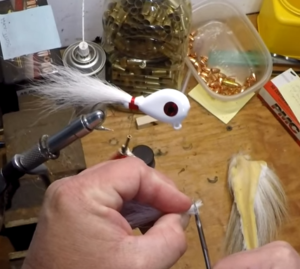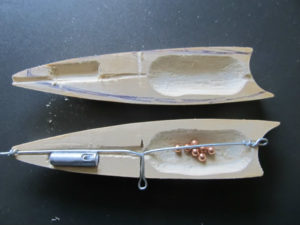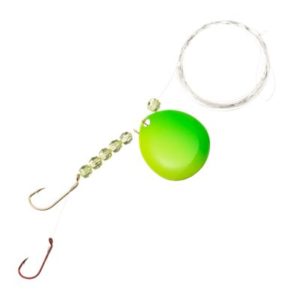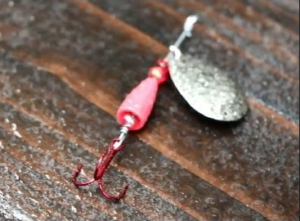How to Tie Your Own Bucktail Jigs
 Whether you fish in freshwater or saltwater, knowing How to Tie Your Own Bucktail Jigs is an important skill to have.
Whether you fish in freshwater or saltwater, knowing How to Tie Your Own Bucktail Jigs is an important skill to have.
Bucktail jigs are known for catching big striped bass in saltwater. But they can also catch some pretty big bass in freshwater too!
Many smallmouth bass anglers rely heavily on bucktail jigs to catch big smallmouths in the colder seasons. And although you don’t hear a lot about them being used for largemouth bass, there are a select handful of anglers who quietly use them to put big green fish in their boat regularly. They just don’t say much about it 😉
So, with all of that aside, why should you want to learn How to Tie Your Own Bucktail Jigs? Well, for starters they catch the heck out of the fish. They also look much different than most of the retail jigs you can buy at stores on online retailers. And learning how to tie your own bucktail jigs saves you a ton of cash. Nobody out there wants to spend more money than necessary on their fishing tackle!
You can choose to pour your own lead jigs. Or you can buy them already poured for you. Pouring them yourself saves you money, but it also involves your time and effort. So you will want to decide which works better for you.
Either way, once you have some good quality jigs in your hands, then you will need to get ready to start tying bucktail onto them. Learning to tie your own bucktail jigs isn’t extremely difficult, but it does take a bit of practice to get good at it.
We’ve taken all of the guess work out of it for you. We have included a video below that will walk you through the steps and have you tying your own bucktail jigs in no time at all. Just be patient and take your time.
And don’t expect to become an expert overnight. But give it some practice and you’ll soon be doing this like it’s nothing at all.
Have fun tying your own bucktail jigs. But most of all, have fun catching fish on them!
Items used for this project:
- Bucktail Jig Heads
- UV2 Bucktails
- Large Premium Bucktails
- Medium Premium Bucktails
- 4 Inch Scissors
- Nylon Thread
- Head Cement
If you enjoyed this post, please be sure to like it and share it with your friends.
And, as always, if you need any kind of lure-making supplies, be sure to visit our website, at http://lurepartsonline.com

 Making through wire musky lures is something that not a lot of people understand. But in order to make a musky lure that will endure the vicious strikes and severe punishment it will be subjected to, it’s pretty imperative that every lure used to catch musky be fitted with through wire construction.
Making through wire musky lures is something that not a lot of people understand. But in order to make a musky lure that will endure the vicious strikes and severe punishment it will be subjected to, it’s pretty imperative that every lure used to catch musky be fitted with through wire construction.
 If you fish for Walleye, you’ll want to learn How to Tie Your Own Walleye Spinner Rigs. Walleye are one of the most sought after gamefish species in many regions of the world.
If you fish for Walleye, you’ll want to learn How to Tie Your Own Walleye Spinner Rigs. Walleye are one of the most sought after gamefish species in many regions of the world. In the bass fishing world, the Bluegill pattern is one of the most popular crankbait patterns sold everywhere. That’s why Custom Painting a Bluegill Crankbait is a critical skill to learn if you want to sell your lures to others. Bluegill patterns flat out catch fish!
In the bass fishing world, the Bluegill pattern is one of the most popular crankbait patterns sold everywhere. That’s why Custom Painting a Bluegill Crankbait is a critical skill to learn if you want to sell your lures to others. Bluegill patterns flat out catch fish! If you make a simple inline spinner from a kit, you’ve just made one of the best fish catchers known to man! And because you made it from a kit, you didn’t have to shop around for lots of different parts.
If you make a simple inline spinner from a kit, you’ve just made one of the best fish catchers known to man! And because you made it from a kit, you didn’t have to shop around for lots of different parts.